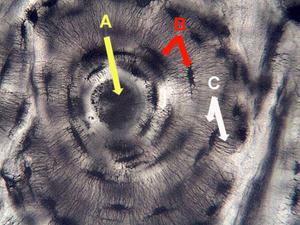Bone
|
|
Bone or osseous tissue has a matrix composed of a solid material called apatite. The matrix is deposited by osteoblasts and osteocytes. Osteoblasts are pre-cursor cells that deposit the bony matrix. As they become encased in bone we call them osteocytes. Compact bone is organized into structures called osteons. The osteons run parallel to the length of the bone. In cross section the osteon resembles a bull's eye. At the center of the bull's eye is the osteonic or Haversian canal, a passageway for an arteriole, veinule and nerve. Surrounding this passageway are layers of bone, shells of bone called lamellae. Visible within the lamellae are dark spots or pits called lacuna. The osteocytes are found in the lacuna. Emerging from the lacunae are lines that extend from the lacuna of one lamella to the lacuna in another lamella. These lines are the canaliculi. They are actually fine grooves in the bone that allow osteocytes to pass along nutrients and waste products. When you first look at your slide the bull's eye structure is easily seen. The spider-like structures are the lacuna (spider body) and the canaliculi (spider legs).
The letter 'A' is pointing at the Haversian or osteonic canal. The arrows associated with the letter 'B' are pointing at lacuna and the arrows associated with the letter 'C' are pointing at the canaliculi.





